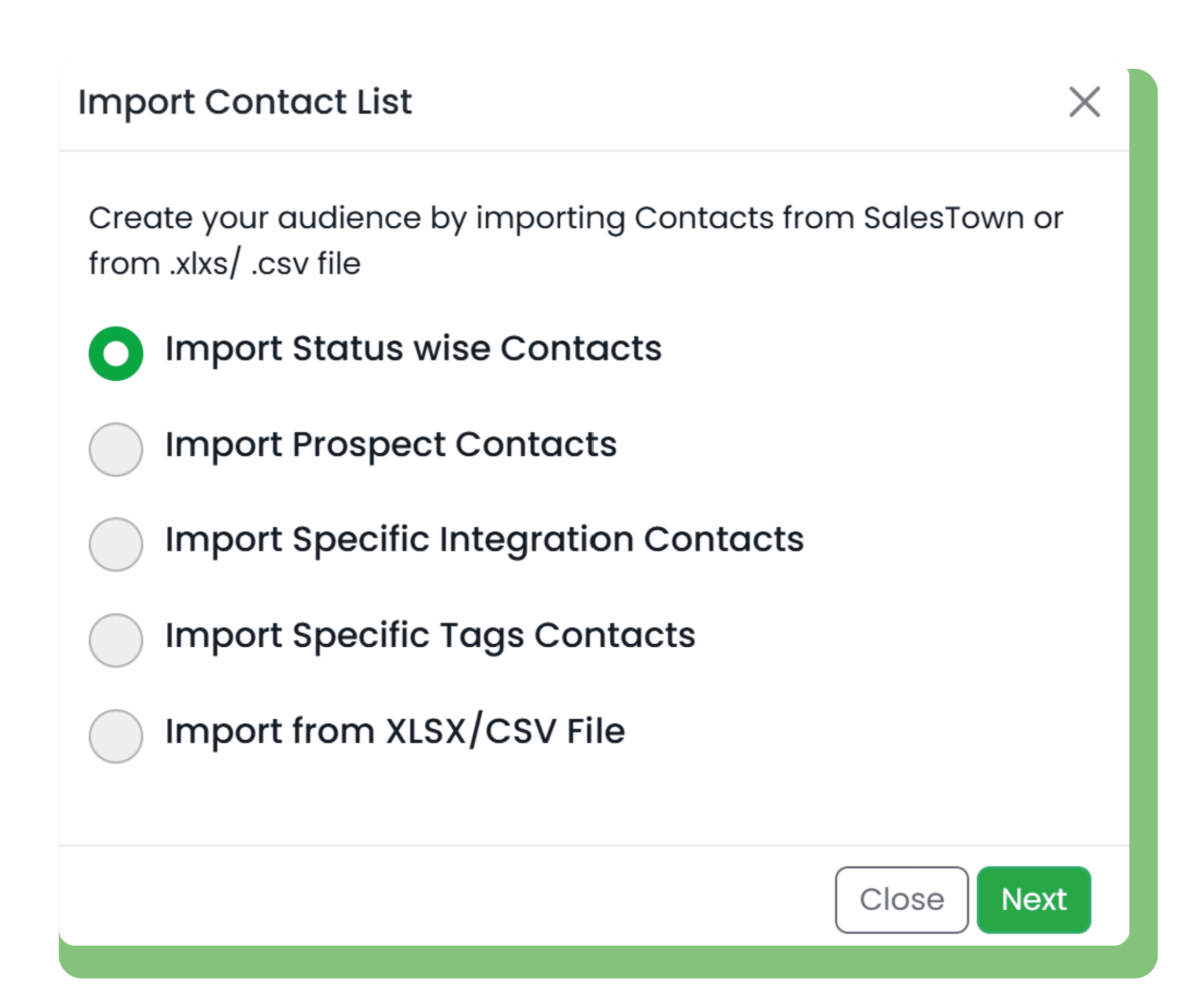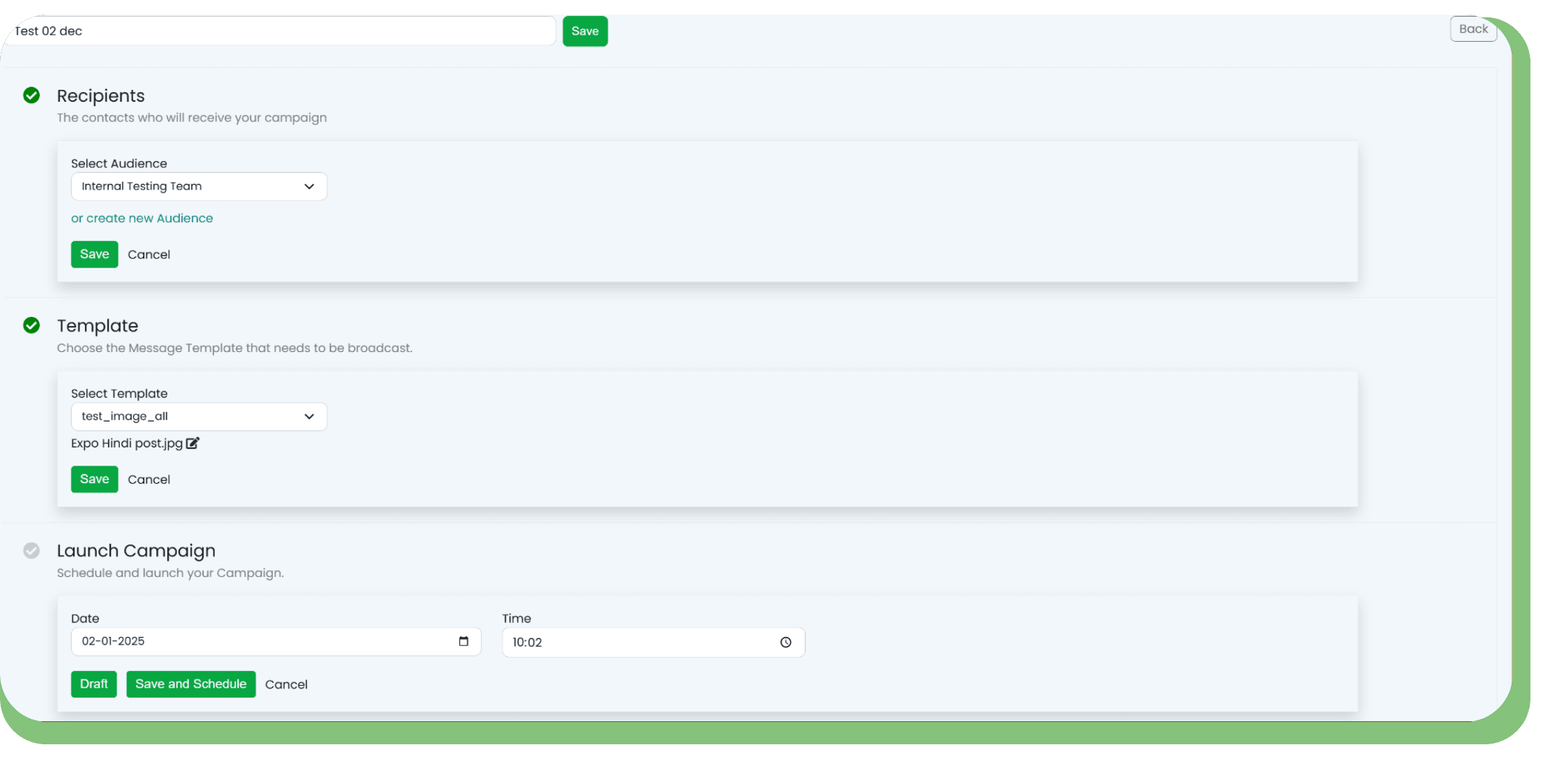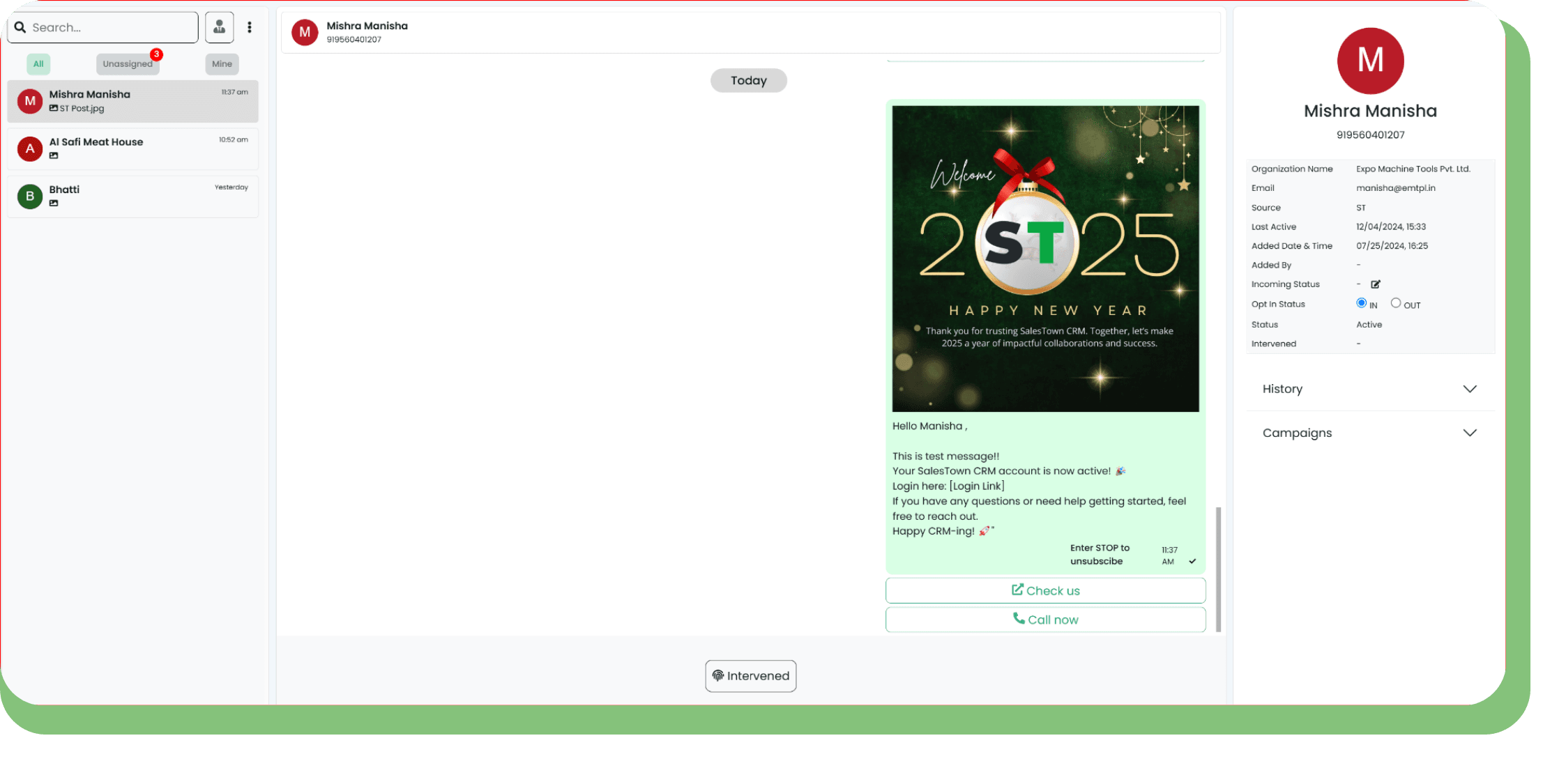Bulk Broadcast WhatsApp Messages sender in 2025: A Comprehensive Guide
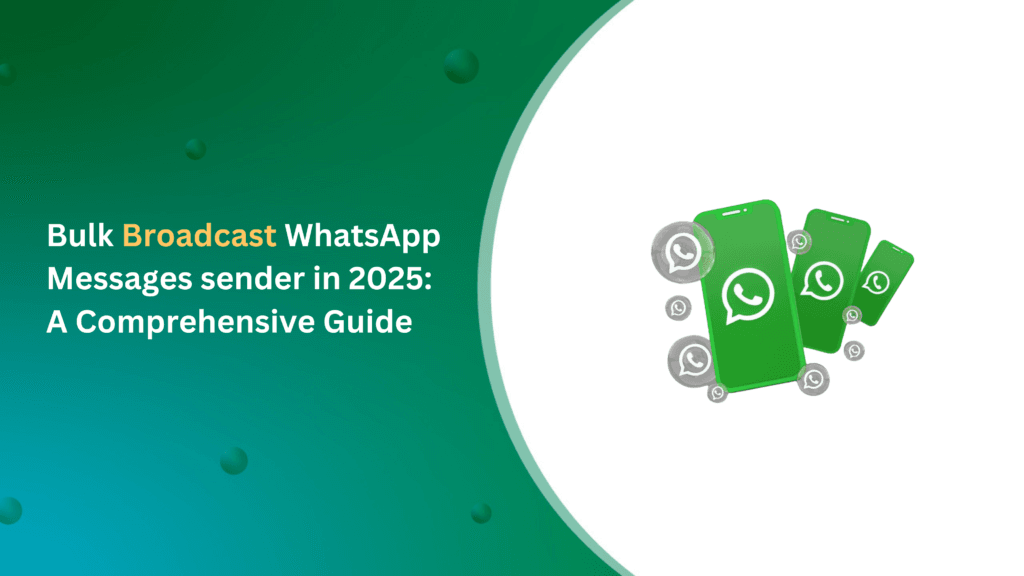
Using a bulk WhatsApp messages sender is getting more popular every year among businesses. With WhatsApp’s massive user base of over 3 billion active users, it has become a top choice for businesses to stay in touch with customers. Whether it’s sharing important updates, promoting offers, or sending reminders, WhatsApp bulk messaging makes communication simple, fast, and effective.
In 2025, bulk broadcast WhatsApp message senders are helping businesses connect with their customers in a more personal way.
This guide will walk you through everything you need to know about using bulk WhatsApp messaging effectively, including how to set it up, best practices, and tips to make your messages more engaging.
What are Bulk Broadcast WhatsApp Messages?
Bulk broadcast WhatsApp messages are a feature that allows businesses to send a single message to multiple recipients simultaneously. Unlike group messages, these messages are delivered individually, ensuring privacy and personalization. This feature is ideal for:
- Important Updates: Inform your customers about critical changes, such as new product launches, service updates, or policy modifications.
- Promotional Offers: Share exclusive deals, limited-time discounts, or special promotions to drive sales.
- Announcements: Communicate company milestones, event invitations, or industry insights.
- Other Relevant Information: Send personalized greetings, reminders, or customer appreciation messages to strengthen connections.
Bulk WhatsApp message sender tools help businesses save time and effort by automating the process of sending messages to a large group of contacts at once. This makes it easy for businesses to maintain consistent communication and stay top-of-mind with their customers. By reaching a broad audience quickly, businesses can ensure their messages are seen and acted upon, improving engagement and driving better results.
Key Benefits of Bulk Broadcast WhatsApp Messages
- Efficient Communication: Send a single message to thousands of customers in seconds.
- Personalized Experience: Tailor messages to individual recipients, enhancing engagement.
- Privacy Guaranteed: Each recipient receives the message privately, maintaining confidentiality.
- Scalability: Reach a wide audience without compromising quality or delivery.
The Importance of WhatsApp for Business in 2025
WhatsApp continues to dominate as a preferred communication channel for businesses worldwide. Here’s why WhatsApp is indispensable for businesses in 2025:
1. Unmatched Global Reach
WhatsApp has over 3 billion active users, making it one of the most widely used messaging platforms globally. Its penetration across diverse demographics ensures businesses can reach customers wherever they are.
2. High Engagement Rates
WhatsApp messages boast a staggering 98% open rate and 45-60% click-through rates, significantly outperforming email marketing and other traditional channels.
3. Enhanced Customer Experience
With features like rich media support and interactive message templates, WhatsApp enables businesses to deliver engaging and value-driven communication.
4. Cost-Effective Marketing
Sending bulk broadcast messages is a cost-effective way to connect with customers compared to traditional advertising methods.
The Latest Updates on WhatsApp Business API in 2025
The WhatsApp Business API continues to evolve, empowering businesses with advanced features that streamline communication and improve campaign performance. Here are the key updates for 2025:
1. Enhanced Message Templates
The updated template editor allows businesses to create, edit, and manage message templates effortlessly. Templates can include dynamic fields for personalization, such as customer names, order details, and more.
2. Rich Media Support
Now, businesses can include rich media such as images, videos, GIFs, audio files, and documents in their messages. This enhances the visual appeal and effectiveness of campaigns.
3. Improved Analytics and Reporting Tools
The new analytics dashboard provides in-depth insights into message delivery, read rates, customer engagement, and campaign performance. This data helps businesses optimize their messaging strategy.
How to Get Started with WhatsApp Business API
To leverage the power of bulk broadcast WhatsApp messages, you need to set up the WhatsApp Business API. Here’s a step-by-step guide:
1. Create a WhatsApp Business Account
- Visit the WhatsApp Business website and register your business account.
- Provide necessary details like your business name, contact number, and email address.
- Verify your account using a one-time password (OTP).
2. Apply for API Access
- Submit an application for API access through WhatsApp or an official partner.
- Approval typically requires a verified Facebook Business Manager account and compliance with WhatsApp’s business policies.
3. Choose an API Provider
- Partner with a reliable API provider like Wati, or Twilio. These providers offer tools to manage bulk messaging campaigns effectively.
4. Configure Your API
- Set up your API credentials, integrate the API with your systems, and start creating message templates.
Setting Up Your Salestown Account
Salestown is an all-in-one platform that simplifies the bulk messaging process. Follow these steps to set up your Salestown account:
- Sign Up on Salestown
- Visit the Salestown website and create an account.
- Choose a pricing plan based on your business needs.
- Link Your WhatsApp Business API
- Integrate your WhatsApp Business API credentials with Salestown.
- Ensure your phone number is verified.
- Create Message Templates
- Use Salestown’s intuitive template editor to design and submit templates for approval.
- Include placeholders for dynamic fields like names, dates, or order IDs.
- Organize Your Contacts
- Import your customer contact list into Salestown. Segment contacts based on demographics, purchase history, or preferences.
- Start Messaging
- Craft, personalize, and schedule bulk messages using Salestown’s dashboard.
How to Send Bulk WhatsApp Messages: Step-by-Step Guide
Sending bulk WhatsApp messages requires careful planning and execution. Here’s a detailed step-by-step guide:
Step 1:
To start your WhatsApp bulk messaging campaign in SalesTown CRM, create a contact list tailored to your audience. Contact List ensures your messages are highly personalized, boosting engagement rates.
- Import Contacts Easily: Use SalesTown CRM’s seamless integration to import Prospects, Active Leads, Won Leads, Lost Leads, or Leads based on specific tags or integrations.
- Excel Upload Option: Download the provided template, fill it with contact details, and upload it effortlessly.

- Manual Entry: Add individual contacts manually for more precise targeting.

Step 2: Design Your WhatsApp Message Template
Create professional, Meta-approved message templates:
- Key Template Details:
- Choose Template Category, then enter Template Name, Language, and Type of template which includes choosing text, image, video, or document formats.
- Enter the Message body and choose variables like Name, Email, and Phone Number to create tailored messages.
- Header and Footer: Add optional components for a polished look.
- Interactive Buttons: Add Call-to-Action buttons (URL or Phone) or Quick Replies.
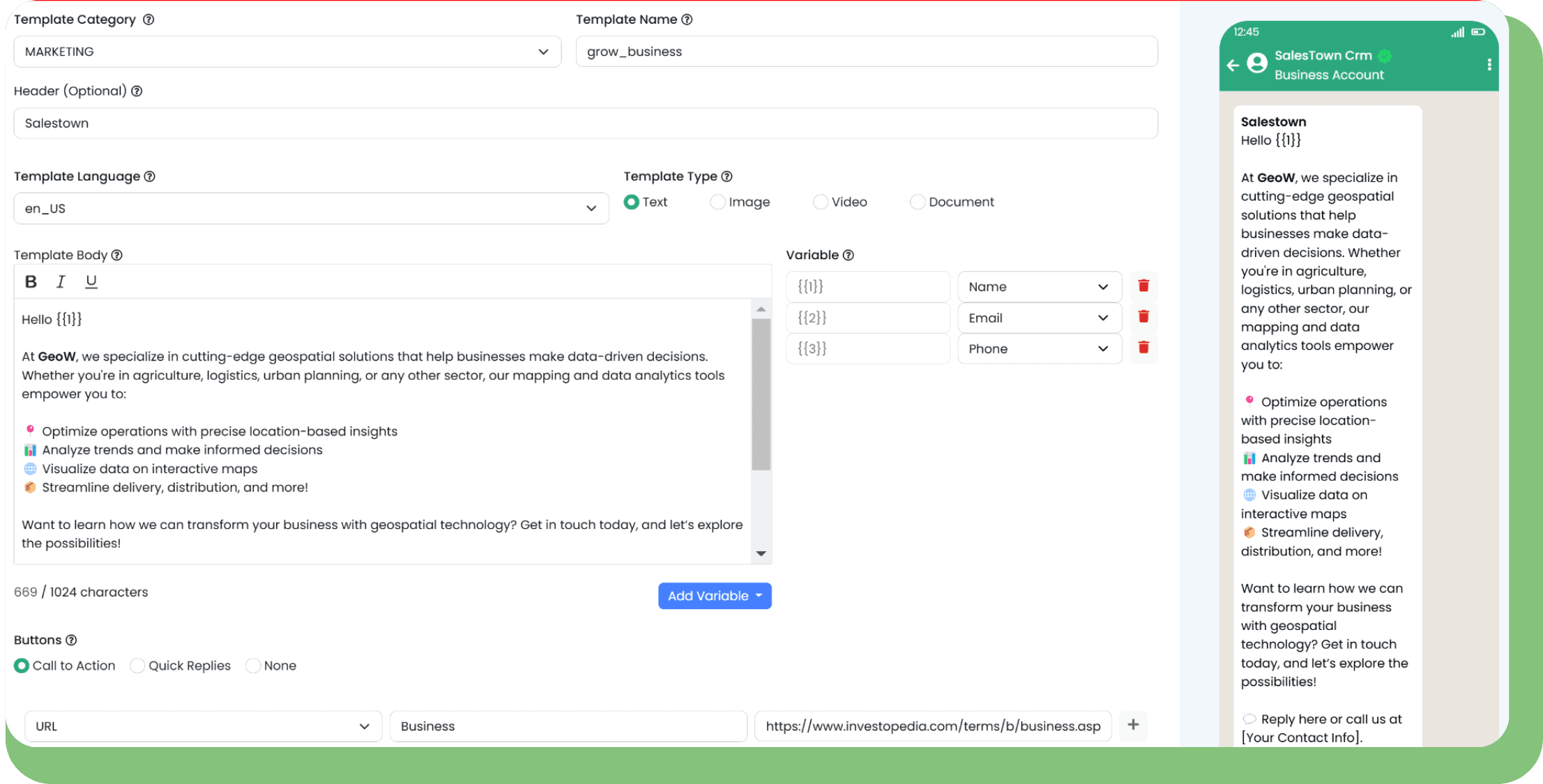
- Preview and Submit: Visualize the message on-screen before submitting it to Meta for approval.
- Approval Status: Meta takes some seconds or a minute to update the status of the created template from Pending to Approved/ Rejected. Approved templates are marked in green and ready to use. Rejected ones are marked in red and cannot be used.
Step 3: Launch and Schedule Your Campaign
- Create Campaign Details:
- Add a unique campaign name and description.
- Select the targeted contact list.
- Choose an approved template and attach relevant media if applicable.
- Schedule with Ease: Set the desired date and time for the campaign to go live.
 Preview and Finalize: Check the complete message and campaign details before clicking Save and Schedule to confirm.
Preview and Finalize: Check the complete message and campaign details before clicking Save and Schedule to confirm.
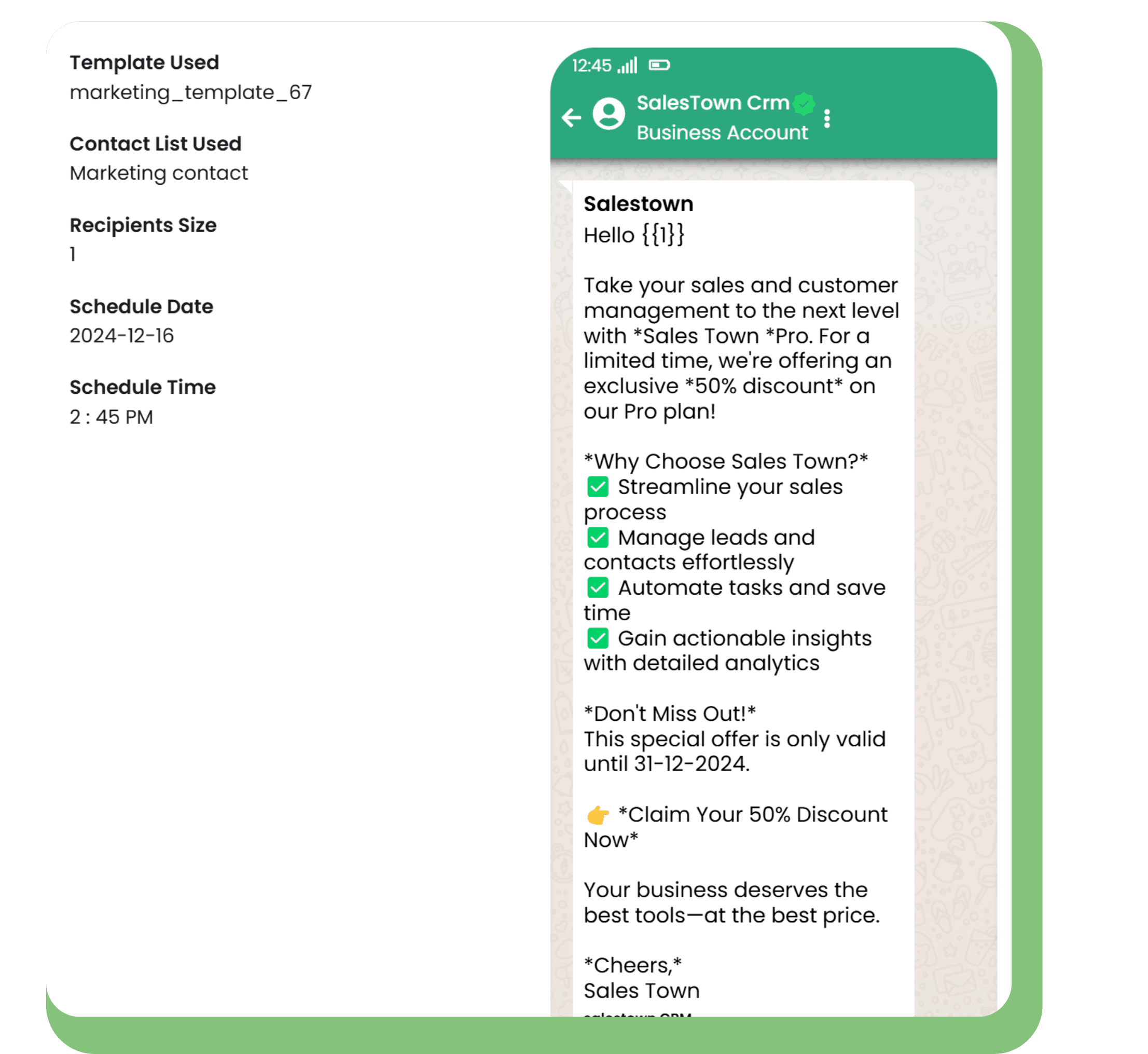
Step 4: Engage with Customers via Live Chat
- Real-Time Responses: All replies from customers will appear in the Live Chat section for up to 24 hours, allowing for instant communication.

- Follow-Up Messages: After 24 hours, chats are automatically moved to Chat Logs, where you can re-engage using approved templates.
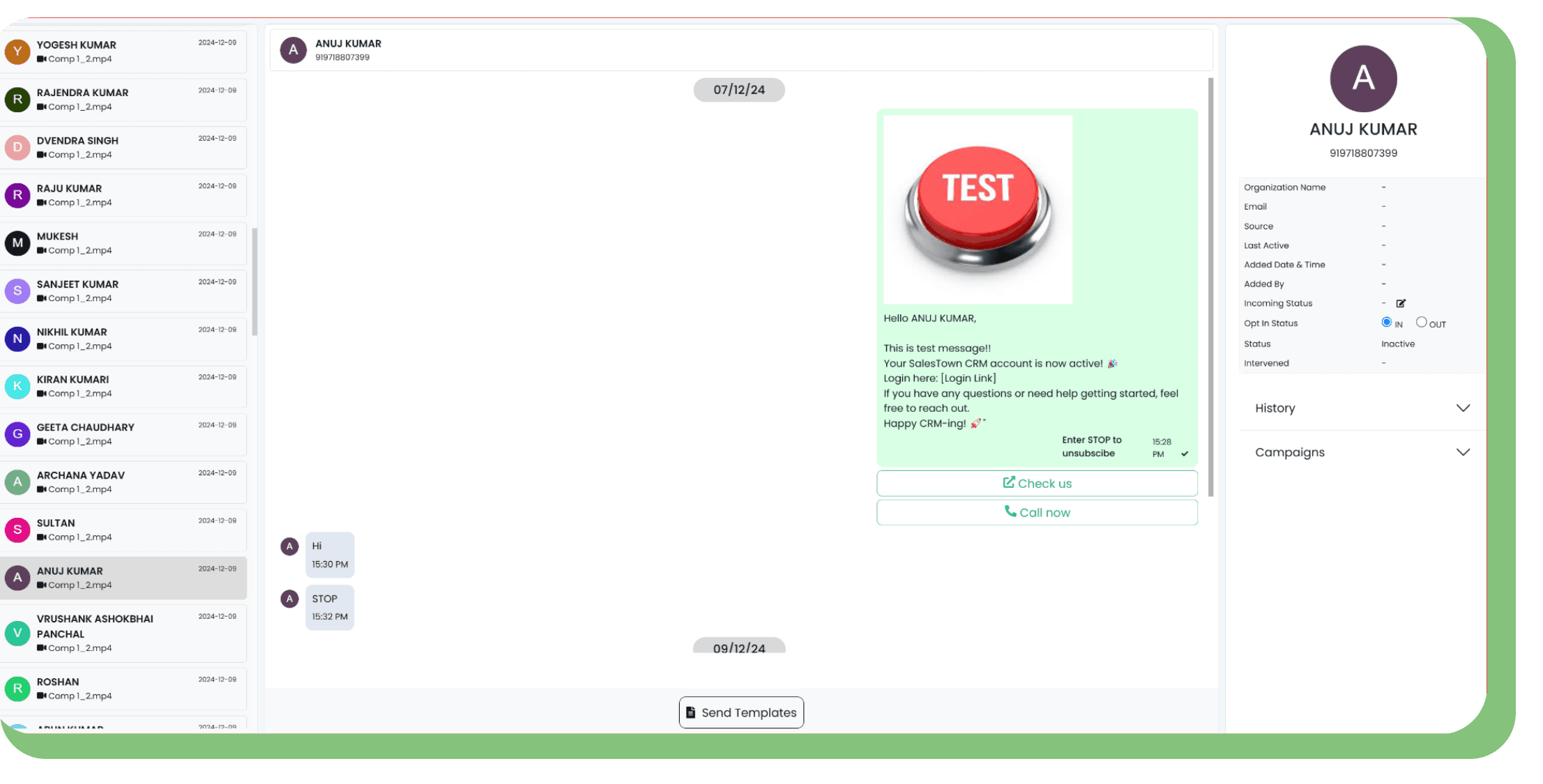
Step 5: Track and Optimize Campaign Performance
- Campaign Analytics: Access detailed reports from the Manage Campaigns section to evaluate metrics like delivery, engagement, and response rates.

- Dashboard Insights: The interactive dashboard showcases a summary of all campaigns, helping you refine future strategies for better results.
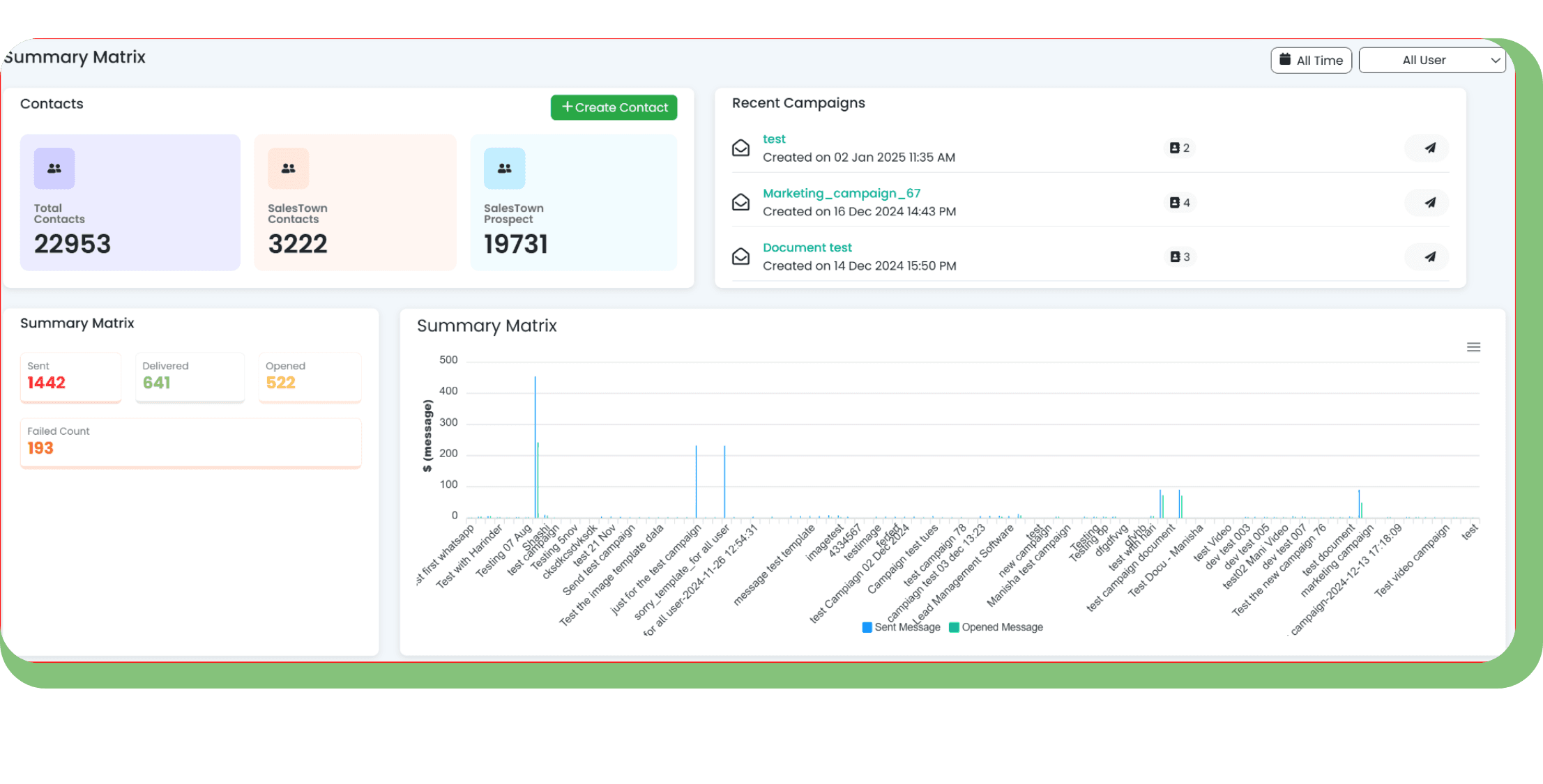
SalesTown CRM’s WhatsApp Marketing feature, ensures seamless bulk messaging, personalized communication, and measurable success for businesses aiming to maximize customer engagement.
Best Practices for Sending Bulk WhatsApp Messages
To maximize the effectiveness of your campaigns, follow these best practices:
- Segment Your Audience
- Tailor messages for specific customer groups based on their preferences or behavior.
- Keep It Concise
- Respect your customers’ time by delivering short and meaningful messages.
- Test Your Messages
- Preview and test messages with a small group to ensure they resonate.
- Analyze and Optimize
- Use analytics tools to track performance and refine your strategy.
Analyzing Your Campaign Performance
Tracking and analyzing your WhatsApp broadcast campaigns is important to understand how well they’re working and how you can improve them. By focusing on key areas, you can make smarter decisions to get better results in future campaigns. Here’s a simple guide to help you analyze your performance:
1. Review Key Metrics
To measure how successful your campaign is, pay attention to metrics like delivery rates, read rates, click-through rates (CTR), and response rates. Delivery rates show how many messages reached your audience, while read rates tell you how many people opened your messages. CTR shows how effective your call-to-action is, and response rates show how many people interacted with your message. By keeping an eye on these, you can figure out what’s working and what needs improvement.
2. Identify Trends
Look for patterns in how your customers behave. Find out when they’re most active on WhatsApp—are they opening messages more in the morning, evening, or weekends? You should also see which types of messages—like special offers or updates—get more responses. Knowing these trends helps you send messages at the right time and with the right content to get the best results.
3. Segment Results
It’s important to look at how different groups of people are reacting to your campaigns. For example, people from different locations or age groups might respond differently. By dividing your audience into smaller groups (or segments), you can send more targeted messages that match each group’s interests. This makes your campaigns more effective and relevant to your customers.
4. Compare Campaigns
Compare the performance of different campaigns to see which ones worked best. For example, compare promotional messages to informational ones and see which type got more engagement. Also, try different message formats—images, videos, or text—and find out which ones your audience likes most. Comparing campaigns helps you understand what strategies to keep using and which ones to improve.
5. Gather Feedback
Asking your customers for feedback is one of the best ways to understand how your campaigns are doing. You can send short surveys or simply ask them for their thoughts. This feedback can show you what customers liked about your messages and what they didn’t. Listening to feedback helps you make your future campaigns even better and more useful for your audience.
Tips to Create Engaging WhatsApp Message Templates
Creating compelling message templates is vital for campaign success. Here are some tips:
- Be Clear and Concise: Avoid lengthy texts; focus on delivering the core message.
- Personalization: Add dynamic fields like customer names or order details.
- Call-to-Action (CTA): Include actionable phrases like “Shop Now” or “Claim Offer.”
- Use Visuals: Add rich media like images, videos, or GIFs for a dynamic message.
- Test and Optimize: Continuously refine your templates based on performance.
- Timing Matters: Send messages at optimal times to maximize engagement.
- Provide Value: Share relevant and useful information.
- Be Human: Use a conversational tone to connect with your audience.
- Avoid Spam: Ensure compliance with WhatsApp’s policies to avoid being flagged.
- Analyze Results: Measure the success of each template and iterate accordingly.
Conclusion
Bulk broadcast WhatsApp messages in 2025 offer businesses a powerful way to connect with their customers. By leveraging the latest features, adhering to best practices, and using advanced tools like the WhatsApp Business API, businesses can drive engagement, build trust, and achieve their communication goals. Start using WhatsApp bulk messaging today to transform your business communication.
Frequently Asked Questions
1. What is bulk broadcast messaging on WhatsApp?
Bulk broadcast messaging on WhatsApp allows businesses to send messages to multiple recipients at once. Unlike a group chat, recipients do not see each other’s replies, maintaining privacy. It’s ideal for sending updates, offers, or announcements to a large audience.
2. Can I send bulk broadcast WhatsApp messages in 2025?
Yes, businesses can still send bulk broadcast messages in 2025 using the WhatsApp Business API. This official API allows you to send messages to a large number of contacts at once while ensuring compliance with WhatsApp’s policies.
3. How can I send bulk broadcast WhatsApp messages?
To send bulk broadcast messages, you need to set up a WhatsApp Business account, apply for the WhatsApp Business API, and choose an API provider like SalesTown. Once set up, you can create contact lists, craft your message, and send it to your audience.
4. What are the requirements for sending bulk broadcast WhatsApp messages?
You’ll need a WhatsApp Business account, access to the WhatsApp Business API, and an approved message template. Additionally, you must comply with WhatsApp’s guidelines to avoid issues like spam or account suspension.
5. How can I maintain the privacy of recipients in bulk broadcast messages?
Recipients in a bulk broadcast list cannot see each other’s contact information or responses, ensuring privacy. To keep things secure, always use the official WhatsApp Business API and avoid third-party tools that might violate WhatsApp’s privacy policies.
6. Can I personalize bulk broadcast messages?
Yes, you can personalize bulk broadcast messages using dynamic fields such as the recipient’s name, location, or other data. This makes the message more relevant to each recipient, improving engagement.
7. How can I avoid being marked as spam when sending bulk WhatsApp messages?
To avoid being marked as spam:
- Only send messages to contacts who have opted in.
- Avoid sending too many unsolicited messages.
- Use approved message templates and follow WhatsApp’s guidelines.
- Keep your messages relevant, clear, and valuable to the recipient.
8. Is it possible to track the delivery and engagement of bulk broadcast messages?
Yes, with the WhatsApp Business API, you can track delivery reports and engagement metrics, such as whether messages were delivered, read, and interacted with. This helps you assess the effectiveness of your campaigns.
9. Are there any limitations or restrictions on sending bulk broadcast WhatsApp messages?
Yes, there are some limitations:
- You can only send messages to contacts who have opted in.
- There are limits on the number of messages you can send per day, depending on your account’s status.
- WhatsApp requires businesses to use approved message templates for certain types of messages, such as promotions or updates.
10. How can I ensure a successful bulk broadcast message campaign?
To ensure success:
- Segment your audience for targeted messaging.
- Craft clear and concise messages.
- Test your messages before sending them to the full list.
- Analyze campaign results and optimize future messages based on performance.

